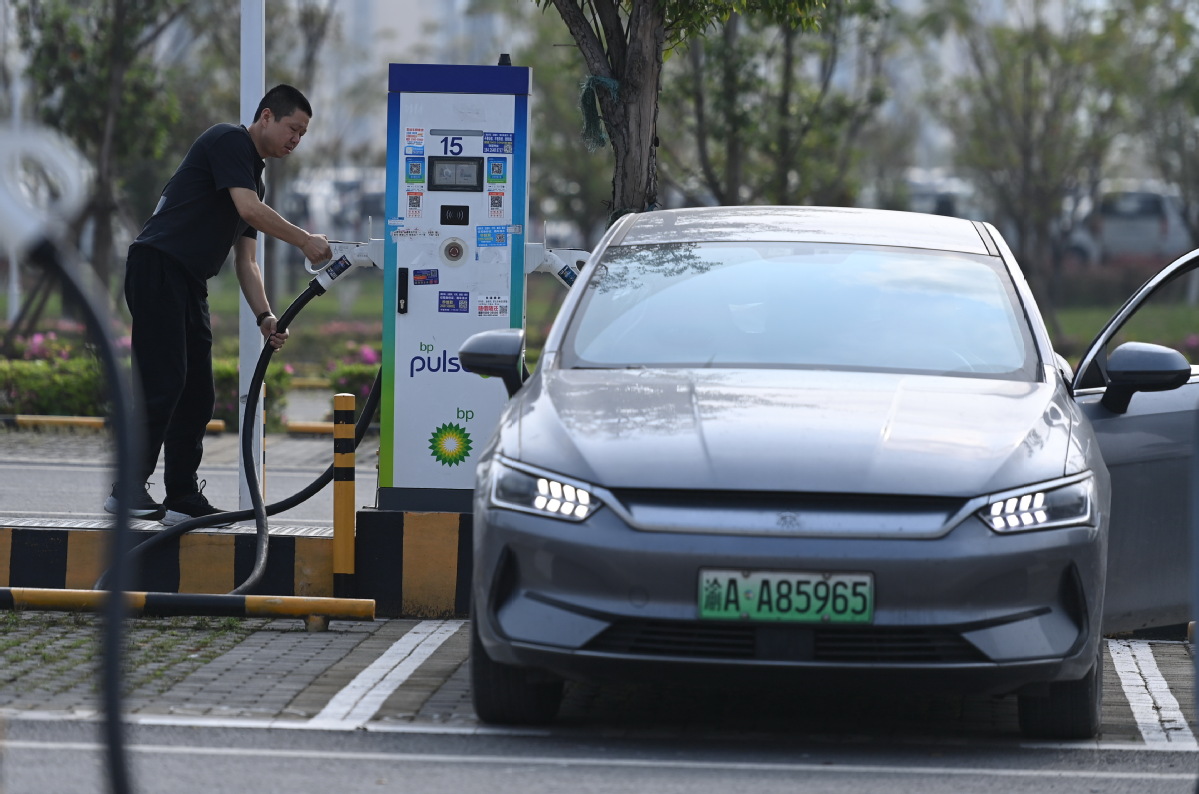
A driver charges his new energy vehicle in Chongqing. [SUN KAIFANG/FOR CHINA DAILY]
Fueled by innovative technologies and rapid advances in the renewables sector, China's energy storage capacity is poised for significant growth, the National Energy Administration said on Wednesday.
The country's power storage capacity has steadily increased this year, with over 44 million kilowatts already in operation by the end of June, up 40 percent year-on-year, the energy authority said during a news conference in Beijing.
The government has been continuously advancing energy storage technologies, with several compressed air energy storage, flow battery storage, and sodium-ion battery storage projects put into operation across the nation, Bian Guangqi, an NEA official, said at the conference.
New energy storage, or energy storage using new technologies such as lithium-ion batteries, liquid flow batteries, compressed air and mechanical energy, is an important foundation for building the country's new power system, which enjoys advantages such as quick response, flexible configuration and short construction timelines.
According to Bian, new energy storage systems are playing a critical role in ensuring grid connection of renewable energy, with the equivalent utilization hours of new energy storage in the operating areas of State Grid Corp of China, the country's largest power utility, reaching 390 hours during the first half of 2024, approximately doubling from the first half of 2023.
Meanwhile, figures for that of China Southern Power Grid's operating areas reached 560 hours, nearly matching the total utilization for 2023, he said.
According to Deng Simeng, a senior analyst in renewables and power research at global consultancy Rystad Energy, battery storage is drawing significant attention due to its crucial role and benefits, which include smaller devices, flexible site requirements and shorter construction periods compared to wind, solar and other traditional power sources.
As numerous gigawatt-scale renewable base projects come online in Northwest China, the local grid system must integrate this renewable capacity, optimize power output and manage the intermittency issues associated with wind and solar energy, said Deng.
Given the rapid expansion of renewable installations, accelerating the development of new energy storage solutions will be a crucial breakthrough for the northwestern region. This will help mitigate renewable curtailment and ensure a more resilient and secure power grid, she added.
According to the administration, the northern and northwestern parts of the country have seen the fastest development of new-type energy storage facilities, accounting for over 50 percent of the newly operational energy storage installations nationwide.
In terms of application scenarios, independent energy storage and shared energy storage installations account for 45.3 percent, energy storage installations paired with new energy projects account for 42.8 percent, and other application scenarios account for 11.9 percent.
The installed capacity of renewable energy has achieved fresh breakthroughs. In the first half of 2024, the nationwide newly installed capacity for renewable energy power generation reached 134 million kilowatts, a year-on-year increase of 24 percent, accounting for 88 percent of the total new power generation capacity in the country.
The NEA issued a notice in April titled "Promotion of New Energy Storage Integration and Dispatch Utilization", aimed at standardizing the integration of new energy storage into the grid and promoting efficient dispatch utilization of new energy storage. The notice outlined specific requirements for grid enterprises, power dispatch agencies and new energy storage project units.
The country has also been expanding the scale of charging facilities, with the total number of charging piles nationwide reaching 10.24 million as of the end of June, a year-on-year increase of 54 percent, including 3.12 million public charging piles and 7.12 million private ones.
The total rated power of public charging piles exceeds 110 million kilowatts, meeting the charging needs of 24 million new energy vehicles, it said.
In the first half of the year, the nationwide charging volume for new energy vehicles was around 51.3 billion kilowatt-hours, a year-on-year increase of 40 percent.
Efforts are being made to address the charging infrastructure gap in rural areas, said Zhang Xing, a spokesman of the energy administration.
"We have organized charging infrastructure construction and promotion activities in some counties and towns, and more than one-third of the provinces have extended charging facilities to all townships, strongly supporting the rural adoption of new energy vehicles," Zhang said.





